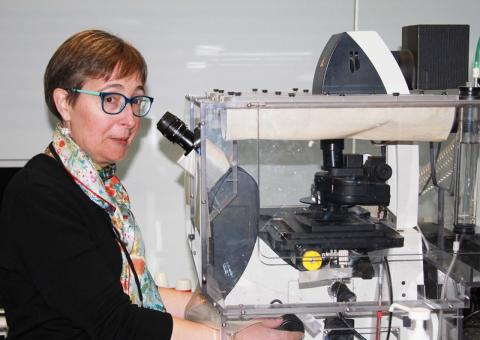
Rachel Méallet-Renault: Bringing out the light
Rachel Méallet-Renault is a physico-chemist, a researcher at the Orsay Institute of Molecular Sciences (ISMO - Université Paris-Saclay/Université Paris-Sud/CNRS), a professor at Université Paris-Sud/université Paris-Saclay and head of the Master of Chemistry program at Université Paris-Saclay. Light is her element. On her research side, she uses it to detect and trap unwanted "objects" such as bacteria or pollutants. On her teaching side, she promotes chemistry among students from the first year of their bachelor's degree to their doctorate.
"My work is mainly focused on the interaction of light and matter," says Rachel Méallet-Renault. At the Orsay Institute of Molecular Sciences (ISMO - Université Paris-Saclay/Université Paris-Sud/CNRS), she develops nanoparticles or light sensitive surfaces to study biological systems, solve environmental problems and turn these nanoparticles into bacteria "detectors".
Luminescent nano-objects
She collaborates with researchers of the Laboratory of Supramolecular and Macromolecular Photophysics and Photochemistry (PPSM - Université Paris-Saclay/ENS Paris-Saclay/CNRS), the Laboratory of Physical Chemistry (LCP - Université Paris-Saclay/Université Paris-Sud/CNRS) and the ISMO, who manufacture nanoparticles of fluorescent polymers that will interact with light. "The objective is to make these particles functional so that they reveal the presence of bacteria by using a signal (a change in colour)," she explains. "I therefore seek to develop luminescent surfaces or nano-objects that are sensitive to the presence of these pathogens, to both detect and repel them. Even if it is still a dream, one day we surely will be able to check whether there is antibiotic resistance or not."
Another aspect of Rachel Méallet-Renault's research concerns energy. A spectroscopist, she collaborates within the CHARMMMAT excellence lab (Chemistry of multifunctional molecular architectures and materials) to develop luminescent surfaces that convert light energy into electrical energy: "I quantify the impact of light on objects to transform this light into electrons".
A doubly enlightened career path...
Passionate about chemistry since high school, Rachel Méallet-Renault obtained her teacher training degree (chemistry option) in parallel with the second examination at the ENS Paris-Saclay. She caught the research "virus" during her DEA internship at the PPSM laboratory. In 2000, she defended a thesis in molecular physico-chemistry. From then on, the young woman had a dual career, in teaching (at the ENS Paris-Saclay from 1995 to 2014) and in research.
In addition to the purpose of research, its aesthetic aspect - such as observing a pink molecule turning to yellow - gives her a lot of "wonder", not to mention the "investigation" that is required. "When I was preparing for aggregation, a question required only one answer. But in research, one question sometimes calls for ten others, without necessarily getting all the answers. It’s a real culture shock! " exclaims the researcher.
...in Saclay
Having obtained a professorship at Université Paris-Sud in 2014, Rachel Méallet-Renault is now leading the masters’ chemistry program at Université Paris-Saclay, with four operating institutions, and continues her research at the ISMO. "The work of a researcher and a teacher-researcher are very different," says the one who likes to claim both hats. For her, research and teaching are above all collective and human adventures. "Sometimes lasting friendships are made with students, who then become colleagues”. In fact, the researcher encourages young people to follow their desires. "If you like science, the thesis is a real professional experience, valuable in both industry and the public sector.”
A humanistic and scientific experience
"We are fortunate to work in a profession with great freedom. There is a way of doing research with humanism in Paris-Saclay, which I appreciate. The diversity of disciplines and institutional cultures, the proximity and power of the platforms enrich us on a daily basis. There is a new community to build based on all this. Another step is now to expand our international reach," concludes Rachel Méallet-Renault.
